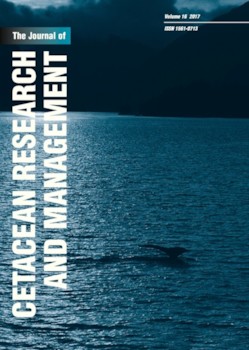Individual gray whale use of coastal waters off northwest Washington during the feeding season 1984–2011: Implications for management
Contenido principal del artículo
Resumen
Gray whales (Eschrichtius robustus) in northwest Washington were studied, with the aims to: (1) increase understanding of gray whale use of the study area; (2) document the annual and seasonal fluctuations in the numbers of whales utilising the area; and (3) assess the fidelity of whales to the study area within and between years. Together these goals establish a baseline of gray whale behaviour during summer and autumn in the region of the Makah Tribe’s proposed whale hunt. From 1984 to 2011, a total of 225 unique gray whales were observed, with 49% being observed again in a future year. There was significant variability in observation rates of gray whales by month and year. During the feeding season, the observation rate increased to a peak in August in the north research segment in the Pacific Ocean and to a peak in October in research segments in the Strait of Juan de Fuca and in the southern research segment in the Pacific Ocean. Gray whales were most commonly observed at depths of 5–15m over rocky substrates and often near kelp forests, although the locations where they fed were dynamic by both month and year. Some whales habitually returned to northwest Washington, however the average whale in the study area was observed in only 31.6% (SE = 1.6%) of the possible years in which they could have been observed. Gray whales in the study area had an average minimum tenure (residency time) of 24.8 days out of a possible 183 days of the feeding season. A discovery curve analysis did not reach an asymptote over the 27 years of this study showing that there is no population closure to the research area. Based on these findings, it can be concluded that even though northwest Washington is an important feeding area, most Pacific Coast Feeding Group (PCFG) gray whales do not have strong fidelity to this one region within the IWC defined PCFG range. The findings presented in this paper provide a baseline for evaluating the impact of Makah hunting activities on the behaviour of PCFG whales that utilise the Makah’s traditional hunting area once hunting activities resume.
Detalles del artículo

Esta obra está bajo una licencia internacional Creative Commons Atribución-NoComercial 4.0.
You are free to:
- Share copy and redistribute the material in any medium or format
- Adapt remix, transform, and build upon the material
- The licensor cannot revoke these freedoms as long as you follow the license terms.
Under the following terms:
- Attribution You must give appropriate credit, provide a link to the license, and indicate if changes were made. You may do so in any reasonable manner, but not in any way that suggests the licensor endorses you or your use.
- NonCommercial You may not use the material for commercial purposes.
- No additional restrictions You may not apply legal terms or technological measures that legally restrict others from doing anything the license permits.

